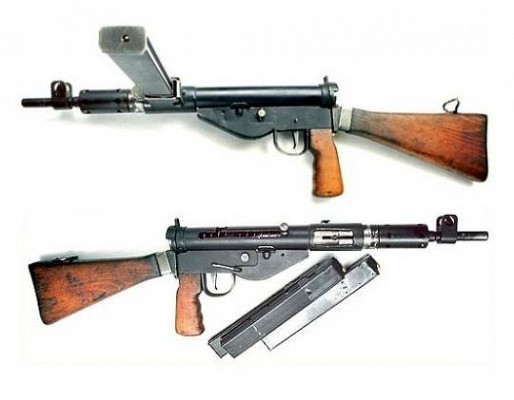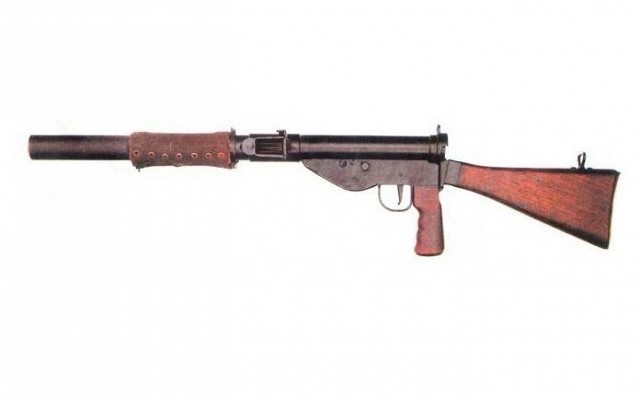Sten
Overview

Sten Mk II
Front view of the iconic Sten Mk II sub machine gun.
Source: www.deactivated-guns.co.uk -
© copyright lies with original owner
Reginald V. Shepherd and Harold Turpin
United Kingdom - Royal Ordnance Factories
United Kingdom - BSA and other companies
Canada - Long Branch Arsenal
Carbine, Machine, Sten (official designation)
MP.748(e) (Beutewaffen index for Mk I)
MP.749(e) (Beutewaffen index for Mk II)
MP.751(e) (Beutewaffen index for Mk IIS)
Description
Introduction
The Sten is a World War 2 era sub machine gun of UK origin. It was developed during the early stages of World War 2 in order to supply British forces with an effective sub machine gun at low cost. The simple design proved to be highly effective and for its role in World War 2 it has become an iconic firearm. Due to its simple design it has been produced in makeshift factories and it was used by various resistance and partisan forces.
Design
The Sten is a blowback operated weapon that fires from the open bolt position. The design is very simple with a tubular receiver, side inserted magazine that doubles as a grip and metal tubular grip and stock. The Mk I and V had a wooden furniture and were of reasonable production quality. The Mk II and III that made up the majority of the production were much cheaper and of limited quality, however still effective and reliable.
Firepower
The Sten fires the 9x19mm round from 32 round magazines. It fires only fully automatic at a rate of fire of about 550 rpm. Due to the open bolt design the maximum range is about 100 meters. The silenced versions were usually fired in short burst or semi-automatically due to their tendency to heat up.
Users
The Sten was widely used by British and Commonwealth forces during World War 2. It was supplied to various allied and resistance forces. After the war it was briefly used by various European nations but it was quickly replaced in Western service by more modern sub machine guns. Many were scrapped or ended up third world nations.
Variants

Sten Mk I
The Mk I is the original version of the Sten and was much more complex and of better quality than the later Mk II and Mk III. The Mk I can be identified by its forward grip, barrel sleeve and flash hider.
Mk I: First production version with wooden forward grip, receiver lining and pistol grip.
Mk I*: Lower cost version of Mk I without wooden furniture.

Sten Mk II
The Sten Mk II is a much simplified version of the Mk I. It is easier and cheaper to produce, but production quality and ergonomics have been reduced. No wooden parts are used and a metal strut is used as stock. The Mk II was the most numerous version of the Sten to be produced, followed by the quite similar Mk III.
Mk II: UK production version of the Mk II.
Mk II (Canadian): The Canadian Mk II is of somewhat better quality than the British production version and has a skeleton type stock.

Sten Mk III
The Sten Mk III is very similar to the Sten Mk II but has a unified receiver and longer barrel shroud. In the Mk III the magazine housing is fixed and cannot rotate. It was produced with the same metal strut stock as the UK production model of the Mk II.

Sten Mk V
The Sten Mk V is a Mk II with wooden stock and improved ergonomics. It has a longer barrel than the Mk III, a bayonet mount and Enfield No.4 rifle forward sight.

Sten Mk IIS
The Sten Mk IIS is a silenced version of the Sten with a long integrated silencer. This version was issued for special operations use. A piece of canvas cloth is wrapped around the silencer to act as a forward grip since the silencer tends to heat up quickly.

Sten Mk VI
The Sten Mk VI is a silenced version of Sten Mk V. It has a similar role as the Mk IIS but comes with the wooden furniture and improved quality of the Mk V.
Details
Related articles

M3 Grease Gun
The American M3 sub machine gun was also developed during World War 2 as a low production cost alternative to the earlier Thompson.

Sudayev PPS-43
The Soviet PPS-43 was also designed for low cost mass production. Earlier Soviet sub machine guns used wooden furniture and were more complex to produce.

Sterling
The Sterling sub machine gun was the successor of the Sten in UK military service. The Sterling has a much higher production quality than the Sten and proved more accurate and reliable.